Camels are large, hardworking animals that are known for their humps and their ability to live in hot, dry places. For centuries, camels have helped people travel, farm, and trade across deserts and rough lands. Calm and gentle when treated well, the camel is a true symbol of patience, endurance, and survival.
Scientific Classification
-
Kingdom: Animalia
-
Phylum: Chordata
-
Class: Mammalia
-
Order: Artiodactyla
-
Family: Camelidae
-
Genus: Camelus
There are three species of camels:
-
Dromedary Camel (Camelus dromedarius) – one hump
-
Bactrian Camel (Camelus bactrianus) – two humps
-
Wild Bactrian Camel (Camelus ferus) – wild and critically endangered
Common Names
-
Camel
-
One-humped camel (Dromedary)
-
Two-humped camel (Bactrian)
-
“Rakumi” (Hausa)
-
“Jamal” (Arabic and Swahili)
-
“Ẹgàn” (Yoruba)
Geographic Distribution
Camels are found in:
-
North and East Africa (especially Somalia, Ethiopia, Sudan, and northern Nigeria)
-
Middle East and Arabian Peninsula
-
Central and South Asia
-
Some deserts of Australia (feral camels)
They live mainly in:
-
Hot deserts
-
Semi-arid lands
-
Dry savannas
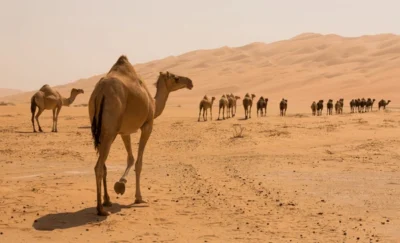
Image Showing a group of camels walking through the desert with sand dunes in the background (Source: Shutterstock).
Breeds of Camels
1. Dromedary Camel (Camelus dromedarius), also known as Arabian Camel.
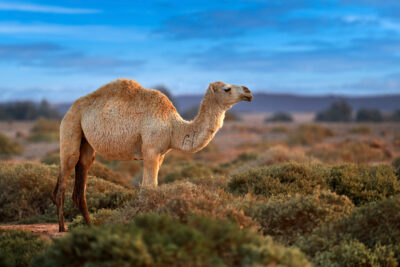
Image showing a group of Dromedary Camel (Source: iNaturalist)
The Dromedary camel is the most common camel species and makes up over 90% of the world’s camel population. It is characterized by a single large hump on its back. These camels are slender and tall, with long legs that help them walk through hot desert sands without sinking. Their coat is typically light brown or sandy beige, which helps them to reflect the harsh desert sun.
They are extremely well adapted to desert climates, especially in North Africa, the Middle East, and parts of South Asia. Their bodies can tolerate extreme dehydration and rehydrate very quickly after finding water.
-
Uses:
Commonly used for riding, carrying loads, and milk and meat production. Their milk is highly nutritious and often consumed in arid regions. -
Key Facts:
-
Lives mostly in the Middle East and North Africa.
-
Can drink up to 100 liters (26 gallons) of water in 10 minutes.
-
Capable of withstanding body temperature fluctuations of over 6°C (11°F) without sweating.
-
2. Bactrian Camel (Camelus bactrianus)
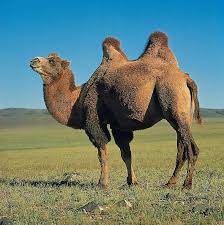
Image showing a group of Bactrian Camel (Source: Britannica)
The Bactrian camel is native to the cold desert steppes of Central Asia. Unlike the Dromedary, it has two humps, which makes it easy to distinguish. Bactrian camels are shorter but stockier than Dromedaries and have thick, shaggy fur to protect against freezing temperatures. Their coats shed significantly during the warmer seasons. They are incredibly resilient in extremely cold temperatures and are used widely in regions like Mongolia, Kazakhstan, and Xinjiang (China).
-
Uses:
Ideal for transportation and carrying loads in mountainous or cold desert regions. Their wool is also harvested and used for clothing and textiles. -
Key Facts:
-
Can tolerate temperatures as low as -40°C (-40°F).
-
Stores fat in its humps, which can be used for energy in extreme conditions.
-
They are more endangered than Dromedaries due to declining habitat.
-
3. Wild Bactrian Camel (Camelus ferus)
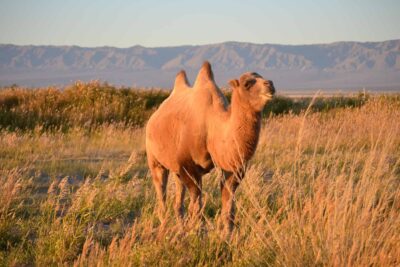
Image showing a group of Bacterian Camel (Source: )
This is a critically endangered species and the only truly wild species of camel. It is similar in appearance to the domesticated Bactrian camel with two humps but is genetically distinct. It is smaller, more slender, and has adapted to the harsh deserts of northwestern China and southern Mongolia (especially the Gobi Desert).
Unlike its domesticated cousin, the Wild Bactrian camel is known to drink saltwater, a rare trait in large mammals. Its population is estimated at fewer than 1,000 individuals, making it one of the most endangered large mammals on Earth.
-
Uses:
Not domesticated. Conservation efforts are ongoing to protect this rare species. -
Key Facts:
-
Listed as Critically Endangered by the IUCN.
-
Only found in the Gobi Desert region.
-
Can survive in nuclear test areas where no other large mammals live.
-
Physical Characteristics
Camels have special features that help them survive desert life:
-
One or two humps (used to store fat, not water)
-
Long legs to keep their body above hot sand
-
Wide feet that don’t sink into sand
-
Long eyelashes and nostrils that close to keep out sand
-
Thick lips to eat thorny desert plants
Size & Weight:
-
Height: About 1.8–2 meters at the shoulder
-
Weight: 300–1,000 kg depending on species
-
Lifespan: 30–40 years
Behavior and Lifestyle
Camels are gentle, social, and intelligent animals. They usually live in groups called caravans or herds.
-
Calm temperament, but can become aggressive if threatened
-
Known for spitting or kicking when upset
-
Obedient when trained
-
Often walk long distances without rest
-
Communicate using grunts, moans, and body language
What do camels eat?
Camels are herbivores that survive on:
-
Dry grasses
-
Thorny shrubs
-
Leaves, grains, and dry grains
-
Dates and salt bushes
They can go for weeks without water, but when they drink, they take in up to 100 liters at once.
Fun facts
-
Camels can go up to 10 days without water in hot climates
-
Their humps can shrink when fat is used for energy
-
A camel’s thick coat helps it stay cool under the hot sun
-
Camels have a third eyelid to protect against sandstorms
-
They are called the “ships of the desert” for their steady movement through sand
Importance to Humans
Camels are deeply valuable in many communities:
-
Transportation: Carry loads and people across deserts
-
Milk: Camel milk is nutritious and easier to digest than cow milk
-
Meat and hides: Used for food, clothing, and tools
-
Trade and culture: Essential to nomadic life and desert economies
-
Tourism: Camel rides attract visitors in desert areas
In some parts of Africa and Asia, camels are also used in farming and ceremonial events.
Health & common issues
Camels are hardy animals but still need care.
Common health problems include the following:
-
Mange and skin infections
-
Foot injuries from long travel or rocky ground
-
Parasites like ticks and worms
-
Respiratory illnesses in dusty or cold weather
-
Digestive issues from poor-quality food
Veterinary Needs:
-
Regular checkups, especially for working camels
-
Vaccination and deworming
-
Hoof trimming and grooming
-
Clean water and good food, especially during travel
Conservation Status
-
Dromedary Camels: Not endangered. Domesticated and widely used.
-
Bactrian Camels: Domesticated type is safe, but wild Bactrian camel is critically endangered
-
Threats include:
-
Habitat loss
-
Hunting
-
Crossbreeding with domestic camels
-
Climate change and water scarcity
-
Countries like China and Mongolia are ensuring efforts to protect wild camel populations. Camels are the quiet heroes of the desert. With their strong legs, patient hearts, and survival skills, they help millions of people every day. Whether carrying goods across sand or providing milk in dry villages, camels are a symbol of balance, tradition, and strength.
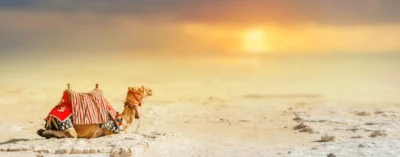
Image Showing a calm camel sitting in the sand, chewing happily, with the sunset in the background (Source: Shutterstock)
In case you need help caring for camels or other large animals You can contact us at Doctor Hulk Veterinary Hospital Today or call 08143397614.








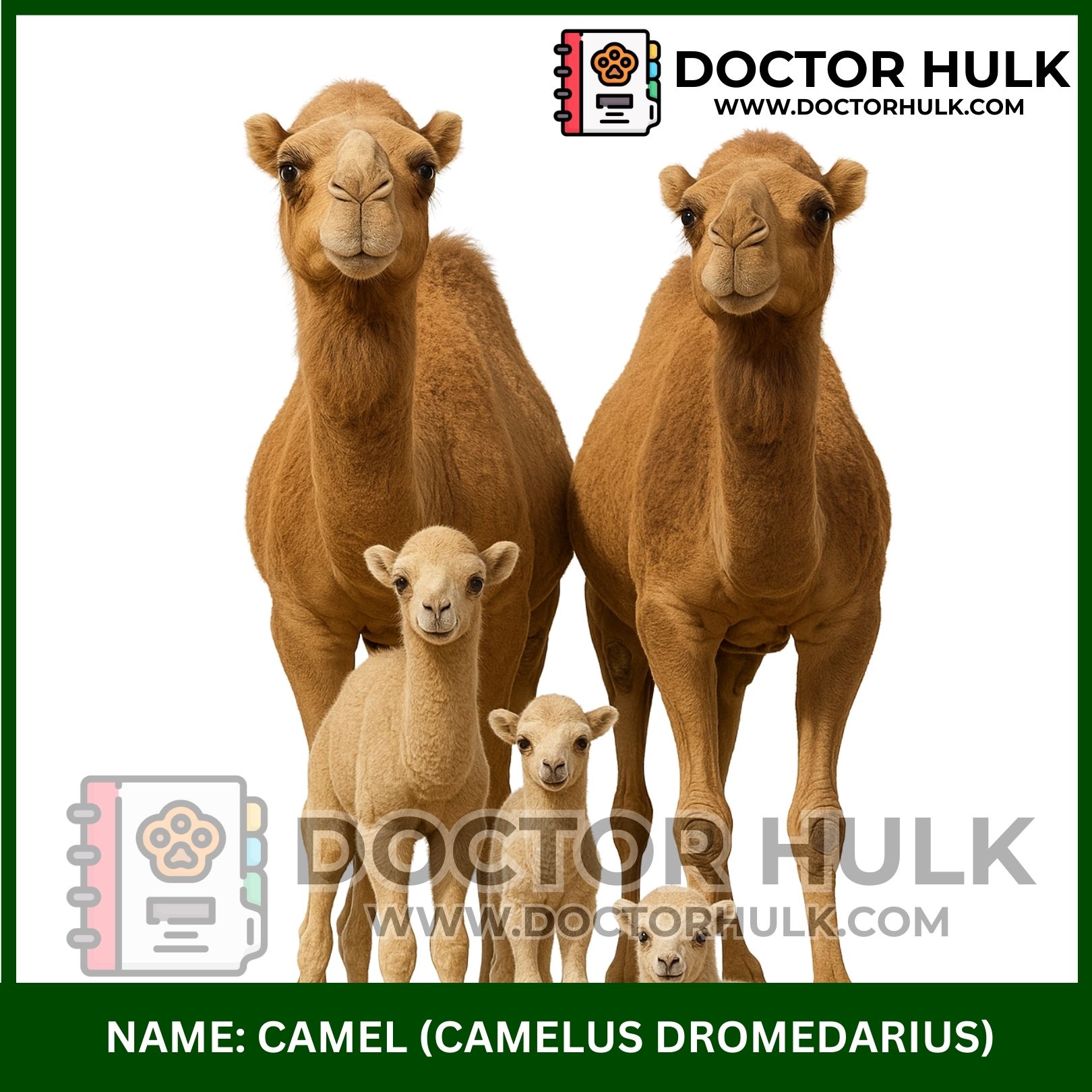

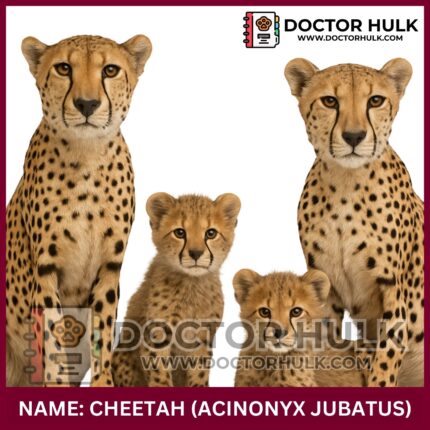


Reviews
There are no reviews yet.